Abstract
Prostanoid receptors belong to the family of G protein-coupled receptors with seven transmembrane domains. By taking advantage of nucleotide sequence homology among the prostanoid receptors, we have isolated and identified a cDNA fragment and its gene encoding a mouse prostaglandin (PG) D receptor by reverse transcription polymerase chain reaction and gene cloning. This gene codes for a polypeptide of 357 amino acids, with a calculated molecular weight of 40,012. The deduced amino acid sequence has a high degree of similarity with the mouse PGI receptor and the EP2 subtype of the PGE receptor, which together form a subgroup of the prostanoid receptors. Chinese hamster ovary cells stably expressing the gene showed a single class of binding sites for [#H]PGD2 with a Kd of 40 nM. This binding was displaced by unlabeled ligands in the following order: PGD2 > BW 245C (a PGD agonist) > BW A868C (a PGD antagonist) > STA2 (a thromboxane A2 agonist). PGE2, PGF2 alpha, and iloprost showed little displacement activity at concentrations up to 10 microM. PGD2 and BW 245C also increased cAMP levels in Chinese hamster ovary cells expressing the receptor, in a concentration-dependent manner. BW A868C showed a partial agonist activity in the cAMP assay. Northern blotting analysis with mouse poly(A)+ RNA identified a major mRNA species of 3.5 kb that was most abundantly expressed in the ileum, followed by lung, stomach, and uterus.
Full text
PDF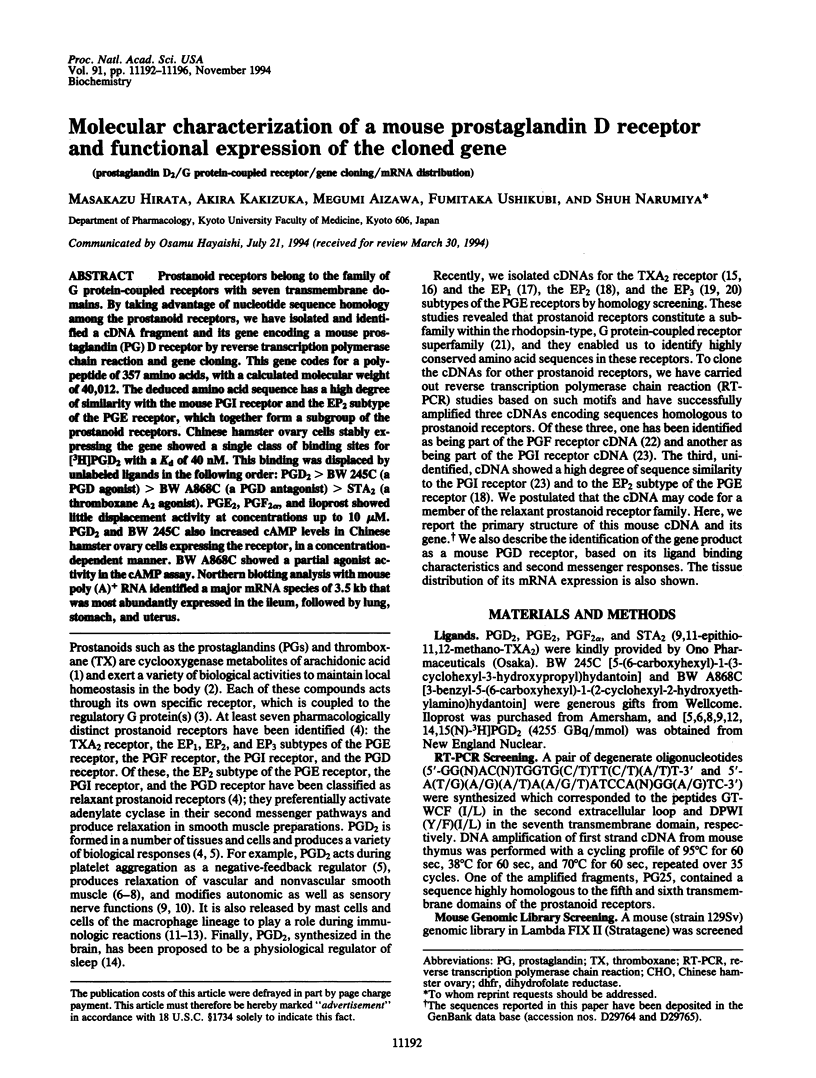
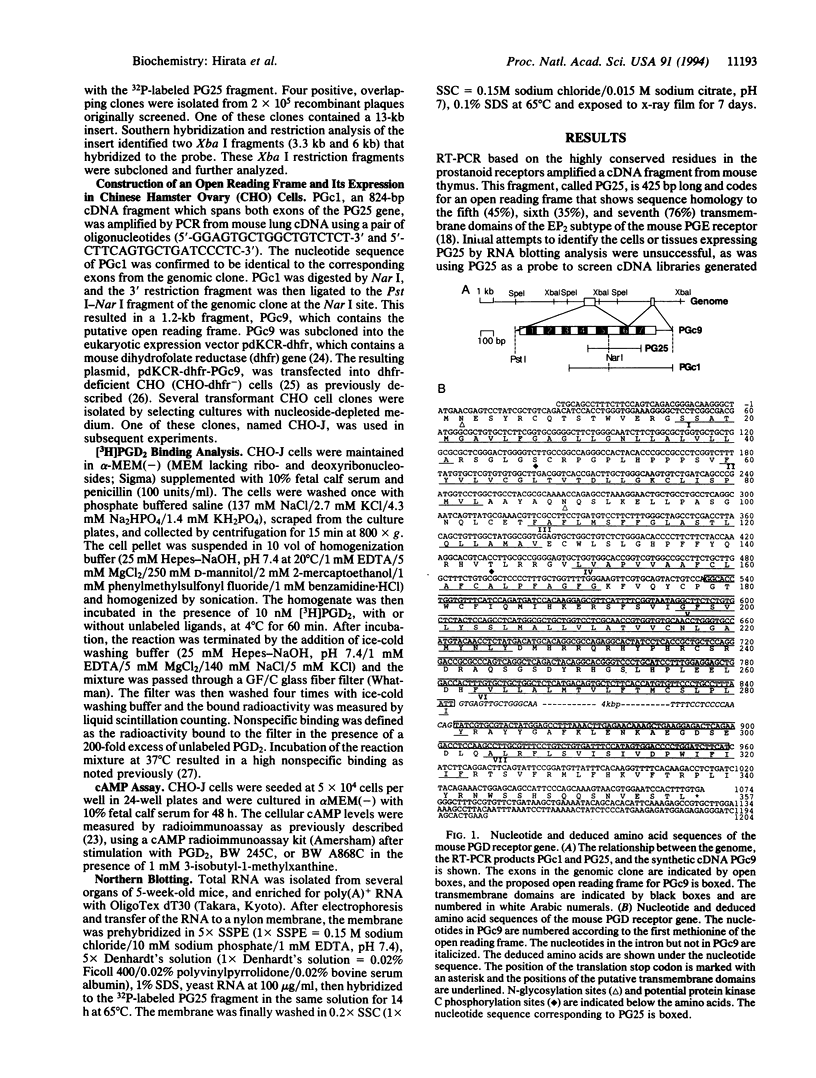
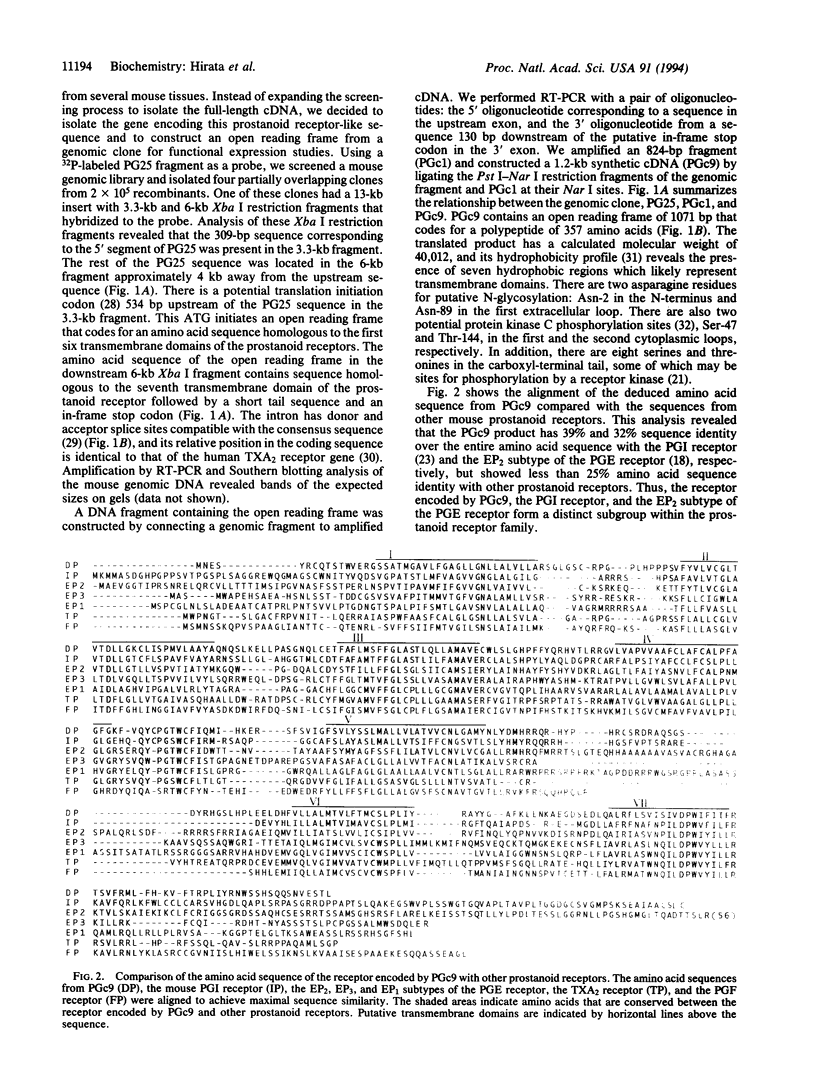
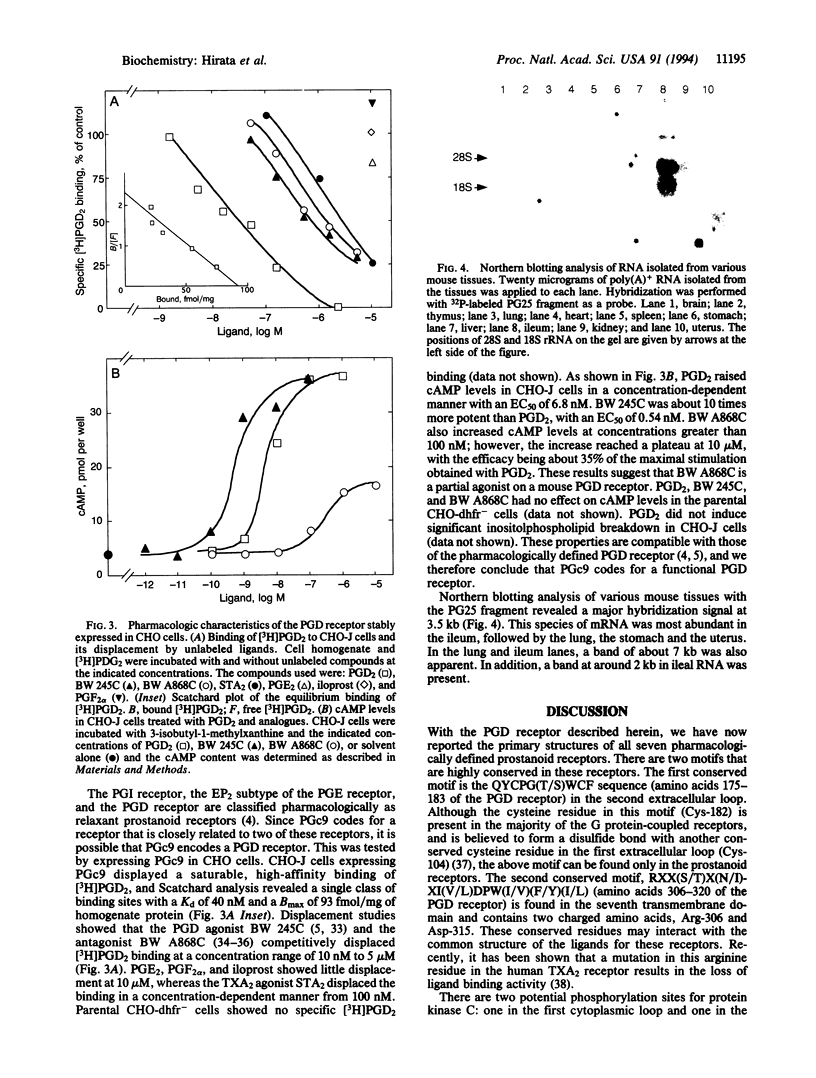
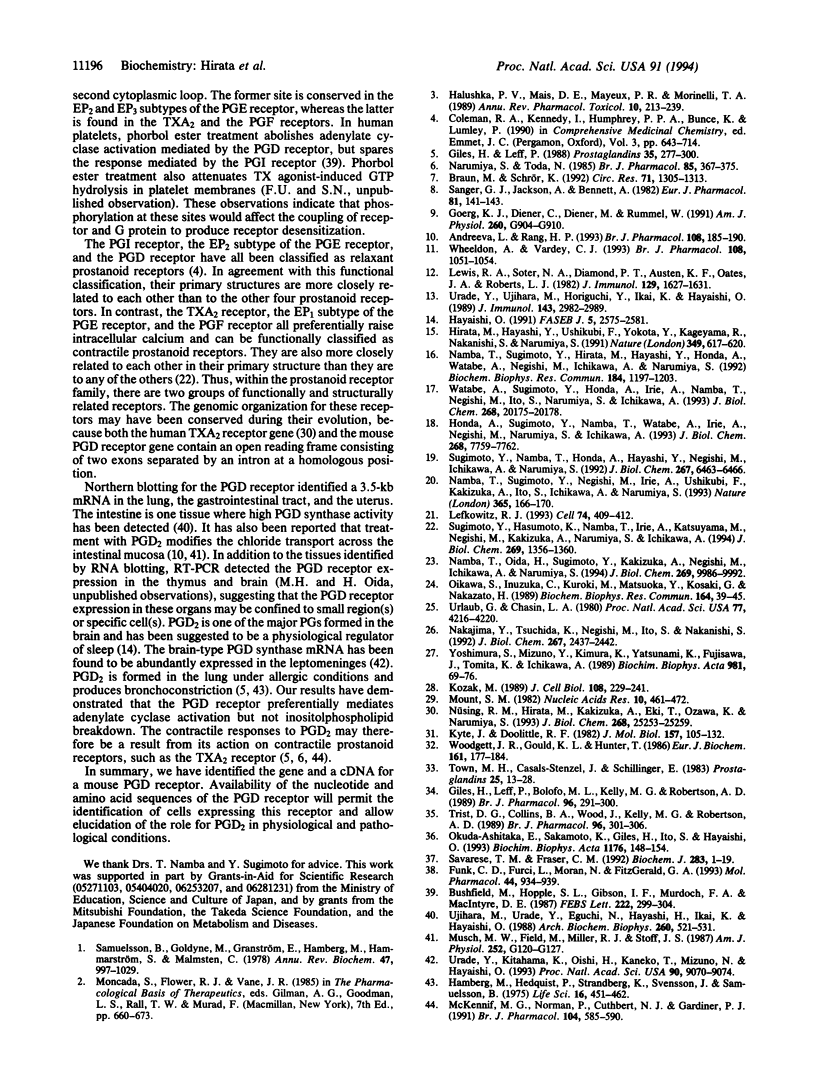
Images in this article
Selected References
These references are in PubMed. This may not be the complete list of references from this article.
- Andreeva L., Rang H. P. Effect of bradykinin and prostaglandins on the release of calcitonin gene-related peptide-like immunoreactivity from the rat spinal cord in vitro. Br J Pharmacol. 1993 Jan;108(1):185–190. doi: 10.1111/j.1476-5381.1993.tb13460.x. [DOI] [PMC free article] [PubMed] [Google Scholar]
- Braun M., Schrör K. Prostaglandin D2 relaxes bovine coronary arteries by endothelium-dependent nitric oxide-mediated cGMP formation. Circ Res. 1992 Dec;71(6):1305–1313. doi: 10.1161/01.res.71.6.1305. [DOI] [PubMed] [Google Scholar]
- Bushfield M., Hopple S. L., Gibson I. F., Murdoch F. A., MacIntyre D. E. Effects of protein kinase C activation on human platelet cyclic AMP metabolism. FEBS Lett. 1987 Oct 5;222(2):299–304. doi: 10.1016/0014-5793(87)80390-3. [DOI] [PubMed] [Google Scholar]
- Funk C. D., Furci L., Moran N., Fitzgerald G. A. Point mutation in the seventh hydrophobic domain of the human thromboxane A2 receptor allows discrimination between agonist and antagonist binding sites. Mol Pharmacol. 1993 Nov;44(5):934–939. [PubMed] [Google Scholar]
- Giles H., Leff P., Bolofo M. L., Kelly M. G., Robertson A. D. The classification of prostaglandin DP-receptors in platelets and vasculature using BW A868C, a novel, selective and potent competitive antagonist. Br J Pharmacol. 1989 Feb;96(2):291–300. doi: 10.1111/j.1476-5381.1989.tb11816.x. [DOI] [PMC free article] [PubMed] [Google Scholar]
- Giles H., Leff P. The biology and pharmacology of PGD2. Prostaglandins. 1988 Feb;35(2):277–300. doi: 10.1016/0090-6980(88)90093-7. [DOI] [PubMed] [Google Scholar]
- Goerg K. J., Diener C., Diener M., Rummel W. Antisecretory effect of prostaglandin D2 in rat colon in vitro: action sites. Am J Physiol. 1991 Jun;260(6 Pt 1):G904–G910. doi: 10.1152/ajpgi.1991.260.6.G904. [DOI] [PubMed] [Google Scholar]
- Halushka P. V., Mais D. E., Mayeux P. R., Morinelli T. A. Thromboxane, prostaglandin and leukotriene receptors. Annu Rev Pharmacol Toxicol. 1989;29:213–239. doi: 10.1146/annurev.pa.29.040189.001241. [DOI] [PubMed] [Google Scholar]
- Hamberg M., Hedqvist P., Strandberg K., Svensson J., Samuelsson B. Prostaglandin endoperoxides IV. Effects on smooth muscle. Life Sci. 1975 Feb 1;16(3):451–462. doi: 10.1016/0024-3205(75)90266-0. [DOI] [PubMed] [Google Scholar]
- Hayaishi O. Molecular mechanisms of sleep-wake regulation: roles of prostaglandins D2 and E2. FASEB J. 1991 Aug;5(11):2575–2581. [PubMed] [Google Scholar]
- Hirata M., Hayashi Y., Ushikubi F., Yokota Y., Kageyama R., Nakanishi S., Narumiya S. Cloning and expression of cDNA for a human thromboxane A2 receptor. Nature. 1991 Feb 14;349(6310):617–620. doi: 10.1038/349617a0. [DOI] [PubMed] [Google Scholar]
- Honda A., Sugimoto Y., Namba T., Watabe A., Irie A., Negishi M., Narumiya S., Ichikawa A. Cloning and expression of a cDNA for mouse prostaglandin E receptor EP2 subtype. J Biol Chem. 1993 Apr 15;268(11):7759–7762. [PubMed] [Google Scholar]
- Kozak M. The scanning model for translation: an update. J Cell Biol. 1989 Feb;108(2):229–241. doi: 10.1083/jcb.108.2.229. [DOI] [PMC free article] [PubMed] [Google Scholar]
- Kyte J., Doolittle R. F. A simple method for displaying the hydropathic character of a protein. J Mol Biol. 1982 May 5;157(1):105–132. doi: 10.1016/0022-2836(82)90515-0. [DOI] [PubMed] [Google Scholar]
- Lefkowitz R. J. G protein-coupled receptor kinases. Cell. 1993 Aug 13;74(3):409–412. doi: 10.1016/0092-8674(93)80042-d. [DOI] [PubMed] [Google Scholar]
- Lewis R. A., Soter N. A., Diamond P. T., Austen K. F., Oates J. A., Roberts L. J., 2nd Prostaglandin D2 generation after activation of rat and human mast cells with anti-IgE. J Immunol. 1982 Oct;129(4):1627–1631. [PubMed] [Google Scholar]
- McKenniff M. G., Norman P., Cuthbert N. J., Gardiner P. J. BAY u3405, a potent and selective thromboxane A2 receptor antagonist on airway smooth muscle in vitro. Br J Pharmacol. 1991 Nov;104(3):585–590. doi: 10.1111/j.1476-5381.1991.tb12473.x. [DOI] [PMC free article] [PubMed] [Google Scholar]
- Musch M. W., Field M., Miller R. J., Stoff J. S. Homologous desensitization to prostaglandins in rabbit ileum. Am J Physiol. 1987 Jan;252(1 Pt 1):G120–G127. doi: 10.1152/ajpgi.1987.252.1.G120. [DOI] [PubMed] [Google Scholar]
- Nakajima Y., Tsuchida K., Negishi M., Ito S., Nakanishi S. Direct linkage of three tachykinin receptors to stimulation of both phosphatidylinositol hydrolysis and cyclic AMP cascades in transfected Chinese hamster ovary cells. J Biol Chem. 1992 Feb 5;267(4):2437–2442. [PubMed] [Google Scholar]
- Namba T., Oida H., Sugimoto Y., Kakizuka A., Negishi M., Ichikawa A., Narumiya S. cDNA cloning of a mouse prostacyclin receptor. Multiple signaling pathways and expression in thymic medulla. J Biol Chem. 1994 Apr 1;269(13):9986–9992. [PubMed] [Google Scholar]
- Namba T., Sugimoto Y., Hirata M., Hayashi Y., Honda A., Watabe A., Negishi M., Ichikawa A., Narumiya S. Mouse thromboxane A2 receptor: cDNA cloning, expression and northern blot analysis. Biochem Biophys Res Commun. 1992 May 15;184(3):1197–1203. doi: 10.1016/s0006-291x(05)80009-9. [DOI] [PubMed] [Google Scholar]
- Namba T., Sugimoto Y., Negishi M., Irie A., Ushikubi F., Kakizuka A., Ito S., Ichikawa A., Narumiya S. Alternative splicing of C-terminal tail of prostaglandin E receptor subtype EP3 determines G-protein specificity. Nature. 1993 Sep 9;365(6442):166–170. doi: 10.1038/365166a0. [DOI] [PubMed] [Google Scholar]
- Narumiya S., Toda N. Different responsiveness of prostaglandin D2-sensitive systems to prostaglandin D2 and its analogues. Br J Pharmacol. 1985 Jun;85(2):367–375. doi: 10.1111/j.1476-5381.1985.tb08870.x. [DOI] [PMC free article] [PubMed] [Google Scholar]
- Nüsing R. M., Hirata M., Kakizuka A., Eki T., Ozawa K., Narumiya S. Characterization and chromosomal mapping of the human thromboxane A2 receptor gene. J Biol Chem. 1993 Nov 25;268(33):25253–25259. [PubMed] [Google Scholar]
- Oikawa S., Inuzuka C., Kuroki M., Matsuoka Y., Kosaki G., Nakazato H. Cell adhesion activity of non-specific cross-reacting antigen (NCA) and carcinoembryonic antigen (CEA) expressed on CHO cell surface: homophilic and heterophilic adhesion. Biochem Biophys Res Commun. 1989 Oct 16;164(1):39–45. doi: 10.1016/0006-291x(89)91679-3. [DOI] [PubMed] [Google Scholar]
- Okuda-Ashitaka E., Sakamoto K., Giles H., Ito S., Hayaishi O. Cyclic-AMP-dependent Ca2+ influx elicited by prostaglandin D2 in freshly isolated nonchromaffin cells from bovine adrenal medulla. Biochim Biophys Acta. 1993 Mar 10;1176(1-2):148–154. doi: 10.1016/0167-4889(93)90190-z. [DOI] [PubMed] [Google Scholar]
- Samuelsson B., Goldyne M., Granström E., Hamberg M., Hammarström S., Malmsten C. Prostaglandins and thromboxanes. Annu Rev Biochem. 1978;47:997–1029. doi: 10.1146/annurev.bi.47.070178.005025. [DOI] [PubMed] [Google Scholar]
- Sanger G. J., Jackson A., Bennett A. A prostaglandin analogue which potently relaxes human uterus but not gut muscle. Eur J Pharmacol. 1982 Jun 16;81(1):141–143. doi: 10.1016/0014-2999(82)90613-6. [DOI] [PubMed] [Google Scholar]
- Savarese T. M., Fraser C. M. In vitro mutagenesis and the search for structure-function relationships among G protein-coupled receptors. Biochem J. 1992 Apr 1;283(Pt 1):1–19. doi: 10.1042/bj2830001. [DOI] [PMC free article] [PubMed] [Google Scholar]
- Sugimoto Y., Hasumoto K., Namba T., Irie A., Katsuyama M., Negishi M., Kakizuka A., Narumiya S., Ichikawa A. Cloning and expression of a cDNA for mouse prostaglandin F receptor. J Biol Chem. 1994 Jan 14;269(2):1356–1360. [PubMed] [Google Scholar]
- Sugimoto Y., Namba T., Honda A., Hayashi Y., Negishi M., Ichikawa A., Narumiya S. Cloning and expression of a cDNA for mouse prostaglandin E receptor EP3 subtype. J Biol Chem. 1992 Apr 5;267(10):6463–6466. [PubMed] [Google Scholar]
- Town M. H., Casals-Stenzel J., Schillinger E. Pharmacological and cardiovascular properties of a hydantoin derivative, BW 245 C, with high affinity and selectivity for PGD2 receptors. Prostaglandins. 1983 Jan;25(1):13–28. doi: 10.1016/0090-6980(83)90131-4. [DOI] [PubMed] [Google Scholar]
- Trist D. G., Collins B. A., Wood J., Kelly M. G., Robertson A. D. The antagonism by BW A868C of PGD2 and BW245C activation of human platelet adenylate cyclase. Br J Pharmacol. 1989 Feb;96(2):301–306. doi: 10.1111/j.1476-5381.1989.tb11817.x. [DOI] [PMC free article] [PubMed] [Google Scholar]
- Ujihara M., Urade Y., Eguchi N., Hayashi H., Ikai K., Hayaishi O. Prostaglandin D2 formation and characterization of its synthetases in various tissues of adult rats. Arch Biochem Biophys. 1988 Feb 1;260(2):521–531. doi: 10.1016/0003-9861(88)90477-8. [DOI] [PubMed] [Google Scholar]
- Urade Y., Kitahama K., Ohishi H., Kaneko T., Mizuno N., Hayaishi O. Dominant expression of mRNA for prostaglandin D synthase in leptomeninges, choroid plexus, and oligodendrocytes of the adult rat brain. Proc Natl Acad Sci U S A. 1993 Oct 1;90(19):9070–9074. doi: 10.1073/pnas.90.19.9070. [DOI] [PMC free article] [PubMed] [Google Scholar]
- Urade Y., Ujihara M., Horiguchi Y., Ikai K., Hayaishi O. The major source of endogenous prostaglandin D2 production is likely antigen-presenting cells. Localization of glutathione-requiring prostaglandin D synthetase in histiocytes, dendritic, and Kupffer cells in various rat tissues. J Immunol. 1989 Nov 1;143(9):2982–2989. [PubMed] [Google Scholar]
- Urlaub G., Chasin L. A. Isolation of Chinese hamster cell mutants deficient in dihydrofolate reductase activity. Proc Natl Acad Sci U S A. 1980 Jul;77(7):4216–4220. doi: 10.1073/pnas.77.7.4216. [DOI] [PMC free article] [PubMed] [Google Scholar]
- Watabe A., Sugimoto Y., Honda A., Irie A., Namba T., Negishi M., Ito S., Narumiya S., Ichikawa A. Cloning and expression of cDNA for a mouse EP1 subtype of prostaglandin E receptor. J Biol Chem. 1993 Sep 25;268(27):20175–20178. [PubMed] [Google Scholar]
- Wheeldon A., Vardey C. J. Characterization of the inhibitory prostanoid receptors on human neutrophils. Br J Pharmacol. 1993 Apr;108(4):1051–1054. doi: 10.1111/j.1476-5381.1993.tb13504.x. [DOI] [PMC free article] [PubMed] [Google Scholar]
- Woodgett J. R., Gould K. L., Hunter T. Substrate specificity of protein kinase C. Use of synthetic peptides corresponding to physiological sites as probes for substrate recognition requirements. Eur J Biochem. 1986 Nov 17;161(1):177–184. doi: 10.1111/j.1432-1033.1986.tb10139.x. [DOI] [PubMed] [Google Scholar]
- Yoshimura S., Mizuno Y., Kimura K., Yatsunami K., Fujisawa J., Tomita K., Ichikawa A. Prostaglandin D2 receptor of mastocytoma P-815 cells--possible regulation by phosphorylation and dephosphorylation. Biochim Biophys Acta. 1989 May 19;981(1):69–76. doi: 10.1016/0005-2736(89)90083-7. [DOI] [PubMed] [Google Scholar]




